I've tried to provide the best general information available. However this information may not specifically apply to your orphan. In addition to the information I've provided, at the bottom of this page there are links to some very good sites on raising orphaned baby mice. The first site listed, The Rat Fan Club, is for orphaned baby rats. The process is much the same for mice as rats, except maybe the feeding technique. The catheter that Debbie uses will probably be too large for a baby mouse, but you may be able to get a small mouse sized feeding tube from a vet.
Orphans can be very difficult to hand raise, especially if they are less than a week old. The mortality rate of hand raised orphans is about 50% (Creek Valley Critters says about 75%). If you've never hand raised an orphan, remain optimistic, but be prepared for the worst. Following the instructions provided will give your baby the best chance of survival. Even with the best care, some babies don't survive. They babies that do survive often become very bonded to their owners and can make wonderful pets. Good luck!
The best advice comes from Ann Vole; find a nursing mom to foster the orphan. You can check with local pet shops to see if they have a nursing mom, but it's likely that you won't find one. If you find a foster mom you will still need to care for the baby until you are able to place the baby with her. It would be best if she isn't a first time mom as mice sometimes eat their babies if they are disturbed. A first time mom is more likely to be nervous about having her babies handled. Even if you do find a foster mom you will need to care for the baby until you can place the baby with the mom. If the baby is not active, the first thing you should do is rehydrate if by giving it Pedialyte, which you can get at the grocery. There will be other things you need, but this is the first.
Raising a Baby Mouse Video Series
by Creek Valley Critters on YouTube
Creek Valley Critters has a great series of 10 very nice short videos about raising orphan mice. It will take about 45 minutes to watch them all and are well worth it. Save some time, the first 5 are the most important for a new found orphan, watch the others later.
View all of Creek Valley Critter's videos on YouTube.
Whitney's Method
Whitney has successfully raised 4 orphan deer mice. She has kindly agreed to share the insights she gained from that experience. I've added my own comments where I felt it was appropriate. While my comments may differ from what Whitney says, this should in no way detract from her success. People learn new techniques every day. There are a number of different approaches to raising orphans, this is Whitney's.
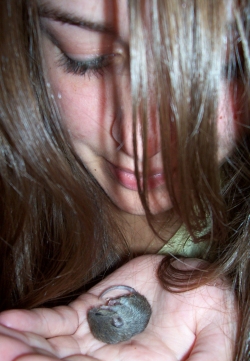
Hydration: I used Pedialyte when I first found (or was brought) the babies for the first 1 or 2 feedings - I can't remember if it was the unflavored one but I kind of think it was. I just went to a local vet hospital at the time and asked for several 1cc syringes which I used for feeding both the Pedialyte and then their formula.
paul's comment: I think new modeling paint brushes are a better feeding device than syringes. The paint brushes allow the baby to more easily suckle and take the formula at their own pace. If paint brushes are not available, you can use the corner of a clean cloth dipped in the formula.
It is difficult for a baby of any kind of animal to take to a formula when they are used to the taste and consistency of their mother's milk. The Pedialyte was a good transitioning liquid that was easily digestible and helped to get them rehydrated since they had each been away from their moms for quite a while.
Pedialyte has a very short shelf life once opened. I believe it should only be used for 48 hours. People should only need to use it for a day or two when they do need it, but it's a good thing to keep another unopened bottle on hand in case it's needed if a baby mouse develops bloat symptoms later on. It's just a good point to remember so that someone doesn't reach back in the fridge for a previously opened bottle if it had been opened for more than 48 hours.
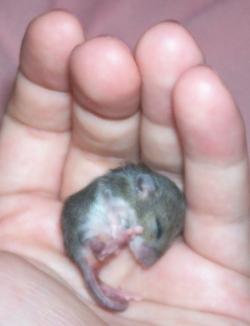
Feeding: I fed them every two hours during the day and every two-three hours at night during their first weeks. I really paid attention to each baby, letting them take as much formula as they wanted, never forcing them. The most important thing to remember when feeding any baby animal is that if they are not actively suckling on their own and you are forcing the food down, it can go down the wrong tube and they can aspirate the milk/formula into their lungs. In most cases, this causes aspiration pneumonia and death. So I used the little 1 cc syringes but always let them take only what they wanted at each feeding, and then stopped.
I found Lambert Kay's Mother's Helper™ [brand] formula at a local pet store. I used the powdered kitten version and it was really essential - on the can it says that you can use this particular formula for many kinds of orphaned baby wildlife. All of my orphans took to this formula. It is a thinner formula when mixed than KMR and Esbilac, and I really recommend it for baby mice. I found a link to it which also mentions that it is "recommended for specific orphaned wild animals, too." It can be ordered online (http://www.bestpetsupply.com/brands/Lambert-Kay/2884.asp) if someone can't find it in a local store, although local stores may carry it which would be much faster than ordering online, I know for sure that PetSmart and Walmart don't carry it.
You should never ever microwave formula to reheat it. What I always did was mix a small amount of formula for the day and pour it into a mug, cover it with cling wrap, and put it in the fridge after the first feeding. Then when it was feeding time, I'd take an empty Tupperware container and put some hot water in it and then take the mug of mixed formula out of the fridge and put it in the warmed water. I'd let it sit but would swirl the formula around frequently to get it to be the same temperature all throughout as well as to mix it back up as there may be some settling with powdered formula. I also gently stirred it up usually using my feeding syringe - this is just common sense, but shaking instead of stirring can create bubbles which would not be good for the baby. I'd get the formula to room temperature and pull some up in a syringe and drop some on my wrist each time to test the temperature. Once it was warm enough, I'd take the mug out of the water and head upstairs with it and my trusty little 1 cc syringe to do a feeding.
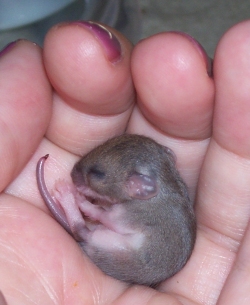
Stimulating: I stimulated them to go to the bathroom as their mother would've by using tiny damp cotton balls - they did get some irritation on their bottoms since water is drying to the skin (even if only a small amount is used) and each had some hair loss in that region due to me doing it but I used a tiny bit of petroleum jelly to sooth their skin there during times of irritation.
paul's comment: I would use a small amount of Neosporin to help prevent any infection.
I only stimulated them to pee/poo until they were old enough where they didn't need it anymore and once they were old enough, walking and running around, the fur they had lost in that region grew in just fine and any remaining irritation resolved.
I mentioned stimulating them to go to the bathroom. Well, their mom would also be licking them and grooming them all over frequently. To simulate or mimic this, I would just very gently and at the same time semi-briskly pet them all over after their feedings with one finger. They would respond as they would have to their mom, by wiggling and cuddling either up to my finger, or into their shredded towel/sock bedding as if cuddling up with their siblings. This is just one small thing people can do to help a baby orphaned mouse to feel comfortable and secure.
I should also mention that each of the babies got some formula build up on their little faces as they ate so I very gently wiped their faces with a damp cotton ball as best as I could after each feeding. Even still, some remained near their whisker area but they cleaned it off as they got stronger/bigger.
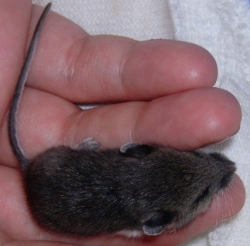
Keeping them warm: Each of the babies was kept in a 10 gallon tank with lots of clean cut up towels and socks. It was comforting to them to be in the torn material, like sleeping with their siblings in their mom's little nest. I changed the "nest" materials daily. I used a mesh top for the tank and kept a towel covering over most of it to keep drafts out. Of course I left about an 1/4 or 1/8 of the top uncovered for air flow. I kept the temperature in the room up a little higher to keep it nice and warm in the whole environment. When I was given Olivia as a tiny pinky mouse, I also kept a heating pad underneath part of the bottom of the tank (not in it) on its lowest setting for the first few days. This added warmth to her tank without the ability to burn or overheat her since it wasn't in the tank. There was also a thick towel stretched across the bottom of the tank as additional protection. I was very careful with keeping the temperature warm and consistent but not too warm as to dehydrate her and made sure it was only underneath part of the tank so that she could move away from it if it was too warm for her. Heating pads can be very dangerous as most people already know - even when kept on the lowest setting, over time they can cause burns and they can also create moist heat which can burn or dehydrate. They should be used and monitored with great care and to those who can't consistently monitor them, I would not recommend their use at all.
paul's comment: Using rags as nesting material poses a risk of the baby getting threads wrapped around its limbs. This can cause the loss of the limb. This has actually happened and if you use rags you need to be careful that this doesn't happen to your babies. Some good alternatives are to use Vellux blanket material. This is the synthetic material that is used in many hotel blankets. It is made up of many short fibers attached to the blanket core. It is very soft and warm. Vellux is a brand name and may go by other names. I purchased some scraps very inexpensively from Joanne Fabrics. I believe they call it something like Blizzard and Artic Fleece. This is a light and warm material that you could make a sort of tent to cover the baby with. You can also place layers of white unscented toilet paper over the baby to hold in the heat. If the baby gets cold, you can warm it in your hand.
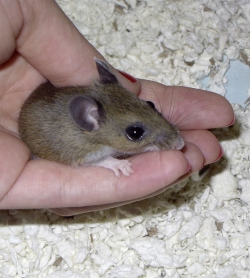
Weaning: When I started transitioning them onto solid food instead of formula, I gave them a tiny pile of seeds to test out and be curious about, but I would also cut a grape in half or in quarters and put that next to it. It got them interested in the seeds and helped with weaning them gradually off of the formula.
To help transition them to water I used a small lid to a small butter or yogurt container. I filled the groove around the edge of the lid with formula. The babies would climb onto the top since it was flat and they'd drink out of the little groove. Of course the formula dried out semi-quickly, so I had to be around to change it - but it got them used to the idea of drinking out of the track. To get them use to drinking water I watered down the formula until it was just plain water. Then I graduated them up to regular water bottles that are commonly used for domestic mice as they got bigger. They are so smart and quickly picked up on how the water bottle worked.
I hope this didn't just confuse things with too much information. Let me know if you have any questions and please let me know how the little ones are doing.
paul's comment: When I weaned babies I would place plastic bottle caps in the cage, one with just formula, and one with rolled oats (uncooked oatmeal) soaked in formula, a third with just dry rolled oats and finally one for water. Rolled oats works well as a transition food and is soft enough for young mice to chew. Change the formula a few times a day as it dries out. The rolled oats will last a long time.
DO NOT feed cow's milk. Cow's milk is difficult to digest. Different people have had good luck with different types of formula. There are a number of different formulas that people recommend. Currently I'm recommending goat's milk. Goat's milk is relatively cheap and easy to find at the grocery. It is also easily digestable by baby mice. Some other options are soy based human formula (recommended by Debbie from The Rat Fan Club), KRM (kitten replacement formula), Esbilac (puppy replacement milk), plain or vanilla flavored soy or rice milk; Creek Valley Critters has their own formula recipe based on goat's milk with other nutritional supplements added. You can make your own rice or oat "milk" by squeezing the water from the cooked rice or oats through a clean cloth. I would mix the oat or rice milk with some other formula for babies that may be fussy eaters. It is good to keep some Pedialyte and distilled water on hand through the entire nursing period.
I recommend mixing powdered formula with distilled water instead of Pedialyte. The formula probably already contains electrolytes and adding Pedialyte may add more than the baby should have. Pedialyte is good place to start as the baby will very likely be dehydrated. If you can't find a syringe, eyedropper or unused modeling paint brush for feeding, you can use the corner of a clean soft cloth. Dip the corner of the cloth in the formula and let the baby suckle from it.
When hand raising deer mice, the greatest problem is that the baby will stop eating. At first the baby seems to be doing fine, but after a few days it refuses to eat and things go downhill from there. It is likely that the baby is suffering from bloat. Bloat is a serious problem that can kill the baby if not treated. Basically bloat is too much gas collecting in the baby's digestive tract, causing the baby to stop eating. Its stomach will become hard and distended and the baby will become less active. Bloating is caused by the baby's inability to digest its food. If your baby is suffering from bloat you should dilute the baby's formula and gently rub the baby's stomach until the bloat has subsided. This may take a few feedings. If you are using a commercial formula you may consider changing the formula. In general more watery formulas seem to work better; these are often the powdered formulas that are mixed with water. Sometimes a specific formula may not agree with the baby and a change may fix the problem. Creek Valley Critters has a very good video on bloat ("Dehydration, Bloat" above).
If your baby is not suffering from bloat and still won't eat, it may simply be that the baby doesn't like what you are trying to feed it. You can try changing formula. I've known one foster parent that couldn't get their baby to eat until they tried vanilla flavored rice milk. He liked that and started eating again. This usually doesn't happen and this may have actually been a case of bloat. Rice milk is pretty thin and that may have helped. It doesn't happen often, but is worth trying, sometimes we just get lucky. It can be difficult to determine the best course of action and sometimes it comes down to your best guess. Of course the more you know, the better your best guess will be.
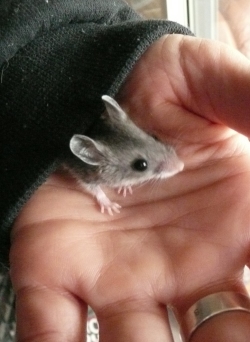
AJ's comments:
When I received Scout he was 3 days away from his eyes opening [about 11 days old] and he did not like the soy infant formula [with] DHA & ARA I offered him, it was a fight every time and I only fed him in the night a couple times. Its amazing that he made [do] on so little food for 3 days before I discovered by fluke that he loved oat milk. I eat soaked thick rolled oats with a tiny amount of honey every morning and on a whim I pulled some of the left over liquid into to dropper and he nearly attacked it! So I made a batch oat milk and used that 50/50 with water and the formula and never had problems again. Might be helpful for someone.
The Recipe: You take 1 cup of oats (like quaker rolled oats) and soak them in 4 cups of water in the refrigerator for 24 to 36 hours, strain out the oats and you have oat milk. Or [you can] make less, they don't eat much of course. No honey or sweetener of any kind for mice. It's a little thick sometimes, so I thinned it with a little water and mixed that with the recommended amount of powdered soy formula. Viola, well fed mouse! Maybe he was just picky, I don't know.
For myself, every morning I put 1/4c rolled oats in a bowl, pour on boiling water and cover with a dish. When its cool enough to eat I stir in maybe a teaspoon of honey. So that first taste of oat milk the day his eyes opened had a little honey in it, but he still liked it without honey after that. I don't give him sugar, salt, fatty or processed food, except for the very rare, tiny treat.
Email AJ to find out more about oat milk for your orphan.I have never raised orphan deer mice or white footed mice except where
I had another nursing rodent on hand (rat, gerbil, house mouse). They all
became healthy adults (except the rat-mothered deer mouse was aggressive
to other mouse-sized rodents and had to be kept with hamsters). My advice
for orphans is to ask around at pet stores, vet offices, etc. and see if
you can find a nursing mother with young babies (so she still has mothering
instincts). Get the orphan's smell all over your hands, then all over the
mother, keep the mother away from the babies for an hour and during that
hour mix the orphans with the mom's litter. It is good to wear gloves during
the handling so you don't mix your smell with theirs. Just before putting
the mom with the babies, DO get your smell on HER but not on the babies.
Sites Providing Additional Advice on Hand Raising Orphans
A lot of the information on these sites is similar, but each author has their own ideas as to what works best. Read them all and see what works best for you.
Email Bucky Goldstein